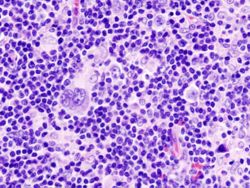The diseases of infancy and childhood (1910) (14763756802)
Identifier: diseasesofinfa00kopl (find matches)
Title: The diseases of infancy and childhood
Year: 1910 (1910s)
Authors: Koplik, Henry, 1858- (from old catalog)
Subjects: Children
Publisher: New York and Philadelphia, Lea & Febiger
Contributing Library: The Library of Congress
Digitizing Sponsor: The Library of Congress
View Book Page: Book Viewer
About This Book: Catalog Entry
View All Images: All Images From Book
Click here to view book online to see this illustration in context in a browseable online version of this book.
Text Appearing Before Image:
nose or intestines. Chills andfever resembling those of paludism are sometimes present. None ofthese symptoms is particularly characteristic. As the disease progresses there are headache and pain in the limbsand in the region of the spleen. The anaemia after a time assumes asevere type, and the skin becomes waxy and yellow. At this stagethe spleen and liver enlarge and distend the abdomen. There aredyspnoea and palpitation; the anaemia takes the hydrsemic form, andthere is oedema of the face, hands, and feet. Hemorrhages then occurfrom the nose, lungs, mouth, intestines, but rarely from the kidneys.There are petechia? in the skin and hemorrhages in the retina. In the lymphatic form the lymph-nodes in various parts of thebody enlarge and form masses which are painless and covered withunaffected skin. The skin may be affected by the process. Themesenteric nodes may sometimes be felt through the abdomen. Thespleen attains an enormous size. The liver may extend as far as the PLATE XXXIII
Text Appearing After Image:
Hodgkins Disease in a Child. DISEASES OF THE BLOOD. 741 umbilicus. Respiratory difficulties, heart weakness, and nervoussymptoms (such as vertigo, somnolence, and coma) end the clinicalcourse of the disease. The urine is diminished, and contains hyalinecasts, lymphoid cells, and a trace of albumin. There may be a slightcontinued fever in the course of the disease. Prognosis.—The prognosis is unfavorable. Of 39 cases collectedby Birch-ITirschfeld, only 4 recovered. Only in the early stage isrecovery possible. Death supervenes from exhaustion with hemor-rhages or from intercurrent pleuritis or pericarditis. Treatment.—The treatment of a disease whose exact nature is stillunknown is difficult. Good food, and hygienic surroundings are thefirst requisite. In the treatment of anaemia, the iodide of iron, cod-liver oil, and arsenic are the chief drugs employed. In the lymphaticform, arsenic in the form of Fowlers solution gives the best results. Hodgkins Disease (Ancemia Lymphatica; Aden
Note About Images
Relevantní obrázky
Relevantní články
Hodgkinův lymfomHodgkinův lymfom [hočkinův lymfom] nebo Hodgkinova choroba je systémové zhoubné nádorové onemocnění mízních uzlin, které je dnes díky moderní léčbě ve značném procentu případů vyléčitelné. Nádorové onemocnění může vzniknout v jakékoli lymfatické tkáni, nejčastěji se to však stává v některé mízní uzlině. .. pokračovat ve čtení







